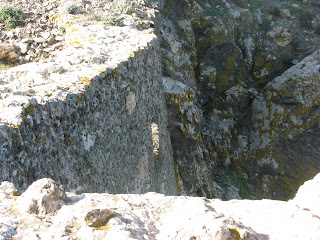 The Kastelli Kefalou is perched on a cliff on the Southwestern part of the island facing the stretch of sea between Kos and Nissyros. To get there you have to take the road south from the town of Kefalos and at the crossroad take the road up onto the mountains, then take the dirt road most to your left at the intersection where you will see a sign for Pyrgi (don't take the road to Pyrgi). Once you get to the end of the dirt road you will see the Kastelli Castle, but you will need to take some goat trails to reach it, it's quite rough...and you will probably get to meet quite a few goats on your way there....
The Kastelli Kefalou is perched on a cliff on the Southwestern part of the island facing the stretch of sea between Kos and Nissyros. To get there you have to take the road south from the town of Kefalos and at the crossroad take the road up onto the mountains, then take the dirt road most to your left at the intersection where you will see a sign for Pyrgi (don't take the road to Pyrgi). Once you get to the end of the dirt road you will see the Kastelli Castle, but you will need to take some goat trails to reach it, it's quite rough...and you will probably get to meet quite a few goats on your way there.... 
As there are no written sources regarding the castle, our knowledge is limited to ceramic finds and to conclusions stemming from the architectural analysis of the place. Some ceramics found in the area, indicate that it was populated since the 13th century. The walls, the fortifications, the cannonholes, the arrowslits, and the similarities with the Hospitaller castle of Antimaheia clearly indicate that the castle was built by the Knights of St John during the early second part of the 15th century. The entrance and the main walls around it are practically all that remain but the castle is situated in a key strategic location and the scenery around it, the hills and ravines on the Northern side as you look out of the gate, and on the south side, the steep overhang where practically only goats dare venture, with it's breathtaking view on the sea, all the way to Nyssiros, are well worth the temerarious visitor's effort.










